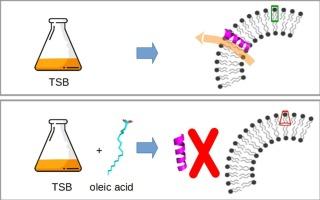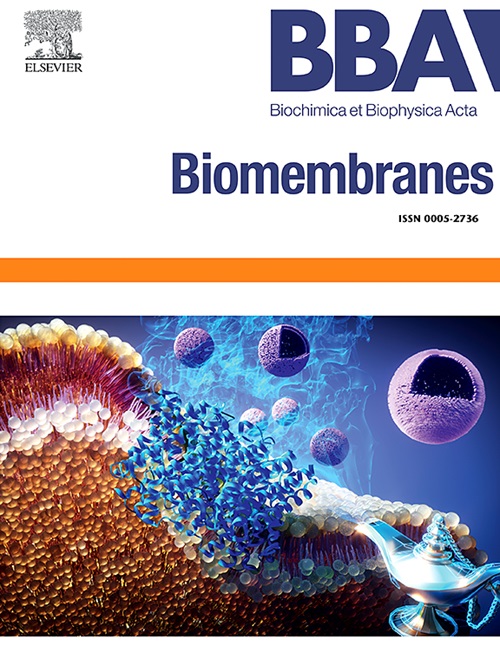Growth of Staphylococcus aureus in the presence of oleic acid shifts the glycolipid fatty acid profile and increases resistance to antimicrobial peptides
IF 2.5
3区 生物学
Q3 BIOCHEMISTRY & MOLECULAR BIOLOGY
引用次数: 0
Abstract
Staphylococcus aureus readily adapts to various environments and quickly develops antibiotic resistance, which has led to an increase in multidrug-resistant infections. Hence, S. aureus presents a significant global health issue and its adaptations to the host environment are crucial for understanding pathogenesis and antibiotic susceptibility. When S. aureus is grown conventionally, its membrane lipids contain a mix of branched-chain and straight-chain saturated fatty acids. However, when unsaturated fatty acids are present in the growth medium, they become a major part of the total fatty acid composition. This study explores the biophysical effects of incorporating straight-chain unsaturated fatty acids into S. aureus membrane lipids. Membrane preparations from cultures supplemented with oleic acid showed more complex differential scanning calorimetry scans than those grown in tryptic soy broth alone. When grown in the presence of oleic acid, the cultures exhibited a transition significantly above the growth temperature, attributed to the presence of glycolipids with long-chain fatty acids causing acyl chain packing frustration within the bilayer. Functional aspects of the membrane were assessed by studying the kinetics of dye release from unilamellar vesicles induced by the antimicrobial peptide mastoparan X. Dye release was slower from liposomes prepared from cells grown in oleic acid-supplemented cultures, suggesting that changes in membrane lipid composition and biophysics protect the cell membrane against peptide-induced lysis. These findings underscore the intricate relationship between the growth environment, membrane lipid composition, and the physical properties of the bacterial membrane, which should be considered when developing new strategies against S. aureus infections.

金黄色葡萄球菌在油酸存在下的生长会改变糖脂脂肪酸谱,并增加对抗菌肽的耐药性。
金黄色葡萄球菌很容易适应各种环境,并迅速产生抗生素耐药性,导致耐多药感染增加。因此,金黄色葡萄球菌是一个重大的全球健康问题,它对宿主环境的适应性对于了解发病机理和抗生素敏感性至关重要。当金黄色葡萄球菌以传统方式生长时,其膜脂质含有支链和直链饱和脂肪酸的混合物。然而,当生长培养基中含有不饱和脂肪酸时,它们就会成为总脂肪酸组成的主要部分。本研究探讨了在金黄色葡萄球菌膜脂中加入直链不饱和脂肪酸的生物物理效应。与仅在胰蛋白酶大豆肉汤中生长的培养物相比,添加了油酸的培养物膜制备物显示出更复杂的差示扫描量热扫描。在有油酸存在的情况下生长时,培养物会出现明显高于生长温度的转变,这归因于含有长链脂肪酸的糖脂的存在导致了双分子层内酰基链堆积失调。通过研究抗菌肽马斯托帕兰 X 诱导的单纤毛膜囊泡释放染料的动力学,评估了膜的功能方面。这些发现强调了生长环境、膜脂成分和细菌膜的物理特性之间错综复杂的关系,在开发抗金葡菌感染的新策略时应考虑到这一点。
本文章由计算机程序翻译,如有差异,请以英文原文为准。
求助全文
约1分钟内获得全文
求助全文
来源期刊

Biochimica et biophysica acta. Biomembranes
生物-生化与分子生物学
CiteScore
8.20
自引率
5.90%
发文量
175
审稿时长
2.3 months
期刊介绍:
BBA Biomembranes has its main focus on membrane structure, function and biomolecular organization, membrane proteins, receptors, channels and anchors, fluidity and composition, model membranes and liposomes, membrane surface studies and ligand interactions, transport studies, and membrane dynamics.
 求助内容:
求助内容: 应助结果提醒方式:
应助结果提醒方式:


